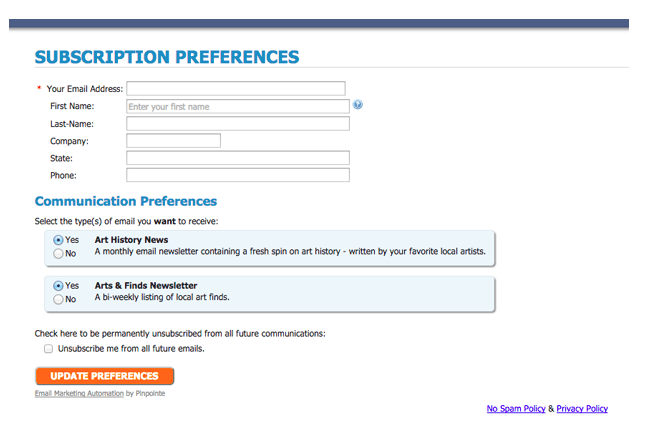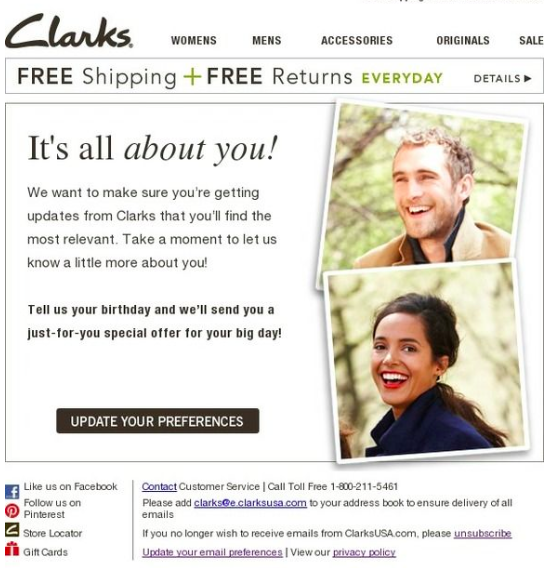Business owners tend to get worried when people unsubscribe from their email list. They typically believe that a smaller list means fewer potential customers, which in turn, means less revenue. Others believe their email marketing strategy is wrong, otherwise no one would leave.
Here’s the thing, not all email list unsubscribes are bad. To help businesses navigate the emotional rollercoaster of unsubscribes, we’ll explain:
- Why people unsubscribe from your list
- Why unsubscribes aren’t a bad thing
- When to worry about unsubscribes
- How to curb unsubscribes
Why do I have email list unsubscribes?
If you’re wondering what sends a subscriber packing, look no further. A recent survey shows the top reasons subscribers leave:
- Emails came too frequently
Fifty-four percent of subscribers say they hit the unsubscribe button because they felt bombarded by emails. The average person receives 216 emails a day, so it’s not surprising to learn that subscribers want to keep their inboxes under control.
- Repetitive content
Forty-nine percent of subscribers say they opt out when email content gets repetitive or boring. Unfortunately, it’s easy for businesses to fall into an email marketing rut, and send the same old messages out.
- Content was never relevant
Twenty-five percent of subscribers say they left a list because the content they received didn’t hit the mark from the start. This likely stems from not knowing your customer base, and not collecting customer information along the way to aid in tailored content.
- Just wanted a special offer
Offering a special deal or discount is a great way to increase your email list, but sometimes those contacts don’t stick around. In fact, the survey shows that 22 percent of customers cash in on a one-time deal and then bail from your list.
- Needs change
Over time, it’s natural for customers to come and go because needs change. Thirteen percent of subscribers say that’s why they abandoned a certain email list.
Subscribers might move to a new city, or get a new job. Interests and circumstances change. The 19-year-old that bought cheap furniture for her studio apartment might change her tastes when she gets a raise and moves to a one-bedroom apartment across town.
- Went to a competitor
This one stings, but eight percent of subscribers unsubscribe because they went to a competitor.
Why email list unsubscribes aren’t a bad thing
Most of the time, you shouldn’t sweat email list unsubscribes, and here’s why:
- More targeted list
If someone who isn’t interested in your product or service leaves, your list is more targeted; customers that won’t result in a sale don’t weigh it down.
- Quality over quantity
It’s better to have 100 customers that care about what you have to say, rather than 200 customers that range in interest from “Yes, I care” to “I don’t give a crap.” Having a list of quality contacts is more beneficial than having a large list of moderately interested contacts.
- Can’t please everyone
Some customers will leave because they’re unhappy, but you know what? You can’t please everyone, and you shouldn’t try. Your product or service is meant for a specific audience, and if someone isn’t interested in it, so be it.
- Save money
Email service providers often charge by list size, so if uninterested people leave your list, you’re actually saving money.
- Save time
When a subscriber opts out, it saves you time when you’re cleaning up your email list. Subscribers that aren’t interested in your product or service that don’t opt out often fall into the in active category. At some point you’ll have to decide whether or not to cut inactive subscribers from your list. If they leave on their own, you don’t have to worry about it.
When to worry about email list unsubscribes
Before you start worrying about email list unsubscribes, check your metrics. What’s your unsubscribe rate? Generally speaking, if your unsubscribe rate is below one percent; you’re within the norm. Ideally, you want to shoot for an unsubscribe rate of 0.05 percent.
If your unsubscribe rate it consistently above one percent, it’s time to start worrying. Or, if you have a relatively low unsubscribe rate and it’s jumped significantly in a short amount of time, that’s cause for concern too.
How to curb email list unsubscribes
Whether you fall into the “time to worry” category or not, here are some steps to take to curb unsubscribes:
- Access your frequency
Since email frequency is the top reason subscribes bow out, you should start your investigation there. How many emails are you sending?
Unfortunately, there isn’t a magic number of emails that you should send per month to keep subscribers happy. It all depends on your audience. Try reducing your email frequency and see if it impacts your unsubscribe rate.
- Segment your lists
If you’re still sending “email blasts” to everyone on your list, your unsubscribe rates could be high. Why? Customers want relevant content. A recent report backs this up with 51 percent of marketers saying relevant content is the most effective email marketing tactic.
Think about it. If you’re a 21-year-old single woman that’s interested in cycling, and you receive emails about kids apparel, would you want to stay on that email list?
Create emails for specific segments of your audience to ensure each group receives relevant content.
- Set up a preference center
Give your subscribers the ability to chose which emails they receive from you by setting up a preference center. Sixty percent of businesses don’t let customers select the types of emails they receive, and 30 percent don’t allow customers to change the frequency, and it’s bad for business.
Without a preference center a subscriber is forced into an all-or-nothing relationship. Either they deal with every email you send, or they unsubscribe. With a preference center, subscribers take an active roll in selecting the kind of communication they want from your business – and that decreases unsubscribes.
Here’s what a subscription preference center from Pinpointe looks like:
Once you have the preference center set up, encourage subscribers to use it by sending an email out like this:
- Ask subscribers what they want
It sounds simple, but one of the best ways to decrease unsubscribe rates is to ask the audience what they want. Create a survey, or turn to social media and ask customers what they’re looking for from your company. Are they interested in how-to articles? Are they looking for more content that provides support after a purchase? Do they want better deals?
By asking customers what they’re looking for, you can create content that’s in line with their needs. It won’t just decrease unsubscribe rates; it should also improve your relationship with customers.
- Access changes
Have you made changes to your email marketing strategy lately? If you have made changes, and your unsubscribe rate is increasing, it’s safe to assume the two are related. Access the changes you’ve made, and make sure they’re in the best interest of your list.
- Send diverse emails
One of the reasons people unsubscribe is because of repetitive, boring content, which means sending a variety of emails is best.
Many businesses rely on coupons or discounts as the bread and butter of their email content, but you shouldn’t forget to send newsletters, emails that encourage subscribers to follow you on social media, birthday wishes, a list of upcoming events and news updates about your business.
If you need a little inspiration, check out this list of email ideas that can increase leads.
Wrap up
While unsubscribes might not be your favorite aspect of email marketing, they’re not always bad. So, remember, don’t panic. In many cases, a subscriber that decides to leave on their own is doing you a favor.
That’s not to say that you shouldn’t work to limit unsubscribes. You can implement some of the suggestions above to keep customers happy, and hopefully, away from the unsubscribe button. Be sure to make changes slowly, and always watch your metrics as you go.








